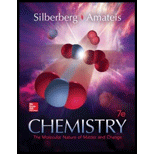
Concept explainers
(a)
Interpretation:
The given equation has to be balanced. Also, the sign and value of
Concept introduction:
Entropy is a
Entropy is the measure of randomness in the system. Standard entropy change in a reaction is the difference in entropy of the products and reactants.
Where,
Standard entropy change in a reaction and entropy change in the system are same.
Entropy
If the disorder increases in a system, then
If the disorder decreases in a system, then
(b)
Interpretation:
The given equation has to be balanced. Also, the sign and value of
Concept introduction:
Entropy is a thermodynamic quantity, which is the measure of randomness in a system. The term entropy is useful in explaining the spontaneity of a process. For all spontaneous process in an isolated system there will be an increase in entropy. Entropy is represented by the letter ‘S’. It is a state function. The change in entropy gives information about the magnitude and direction of a process. The entropy of one mole of substance at a given standard state is called standard molar entropy (
Entropy is the measure of randomness in the system. Standard entropy change in a reaction is the difference in entropy of the products and reactants.
Where,
Standard entropy change in a reaction and entropy change in the system are same.
Entropy
If the disorder increases in a system, then
If the disorder decreases in a system, then
Want to see the full answer?
Check out a sample textbook solution
Chapter 20 Solutions
Chemistry: The Molecular Nature of Matter and Change - Standalone book
 ChemistryChemistryISBN:9781305957404Author:Steven S. Zumdahl, Susan A. Zumdahl, Donald J. DeCostePublisher:Cengage Learning
ChemistryChemistryISBN:9781305957404Author:Steven S. Zumdahl, Susan A. Zumdahl, Donald J. DeCostePublisher:Cengage Learning ChemistryChemistryISBN:9781259911156Author:Raymond Chang Dr., Jason Overby ProfessorPublisher:McGraw-Hill Education
ChemistryChemistryISBN:9781259911156Author:Raymond Chang Dr., Jason Overby ProfessorPublisher:McGraw-Hill Education Principles of Instrumental AnalysisChemistryISBN:9781305577213Author:Douglas A. Skoog, F. James Holler, Stanley R. CrouchPublisher:Cengage Learning
Principles of Instrumental AnalysisChemistryISBN:9781305577213Author:Douglas A. Skoog, F. James Holler, Stanley R. CrouchPublisher:Cengage Learning Organic ChemistryChemistryISBN:9780078021558Author:Janice Gorzynski Smith Dr.Publisher:McGraw-Hill Education
Organic ChemistryChemistryISBN:9780078021558Author:Janice Gorzynski Smith Dr.Publisher:McGraw-Hill Education Chemistry: Principles and ReactionsChemistryISBN:9781305079373Author:William L. Masterton, Cecile N. HurleyPublisher:Cengage Learning
Chemistry: Principles and ReactionsChemistryISBN:9781305079373Author:William L. Masterton, Cecile N. HurleyPublisher:Cengage Learning Elementary Principles of Chemical Processes, Bind...ChemistryISBN:9781118431221Author:Richard M. Felder, Ronald W. Rousseau, Lisa G. BullardPublisher:WILEY
Elementary Principles of Chemical Processes, Bind...ChemistryISBN:9781118431221Author:Richard M. Felder, Ronald W. Rousseau, Lisa G. BullardPublisher:WILEY





